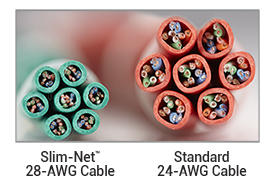28-AWG cable has been gaining many fans and is becoming a more popular choice, especially in high-density data centers and telecom rooms. It offers users a number of advantages, but also comes with some disadvantages, which I will review in this post.
First, what is 28-AWG cable? It’s patch cable made with thinner, 28-AWG, stranded copper conductors as opposed to traditional patch cables made with thicker 24- or 26-AWG conductors.
Here are some of the advantages as to why you may choose 28-AWG cable.
Advantage 1: Space savings. With a typical diameter of only 0.161” (4.1 mm), 28-AWG cable is almost half the size of a typical 24-AWG cable at 0.22” (5.9 mm). This gives you a lot of extra space in cable managers and in pathways. The difference can be dramatic, as shown in this photo of a bundle of 28-AWG cable compared to a bundle of 24-AWG cable.

Advantage 2: Improved airflow.
28-AWG cables are much thinner than traditional 24-AWG cables, so they take up less space in front of patch panels and network equipment resulting in improved airflow and cooling on equipment.
Advantage 3: Easier handling. There’s more space between patched 28-AWG cables, so the cable is much easier to handle. You will find there’s more space for your fingers when doing installs and MACs. Also, it’s much easier to identify port assignments on equipment.
Advantage 4: Fewer cable managers. 28-AWG cables are much less bulky and offer improved flexibility compared to 24-AWG cables. Because of that, you can reduce the number of horizontal cable managers you need, or possibly eliminate them entirely. You will also gain up to 50% more space in vertical cable managers.
Advantage 5: Conserve rack space. You will be able to put more cables in high-density 1U or 2U patch panels freeing up valuable rack units.

Advantage 6: Price 28-AWG cable has less copper in its conductors, so it should cost less than traditional 24-/26-AWG cable, at least Black Box cable costs less. This can add up to significant savings when setting up and patching high-density telecom rooms and data centers with hundreds of cables.
Summary 28-AWG cables offer a great alternative to traditional 24-AWG cable, especially in high-density telecom rooms and data centers where rack space is at a premium. The thinner, .161” diameter is almost half the size of a 24-AWG cable so it’s ideal for saving space, reducing clutter, and improving airflow. It’s easier to handle, so the need for cable managers can be reduced or eliminated. It also costs less than traditional cable.
With almost 50% more space between cables, you’ll like working with 28-AWG cable. It’s much easier to get your fingers in between the cables for patching; easier to identify port designations; and easier to route cables.
While 28-AWG cable is not supported in the TIA 568-C.2 standard, it is a smart alternative for short patches. You can also use 28-AWG on one end and 24-AWG cable on the other end.
Black Box offers 28-AWG cable for CAT6 and CAT6A in seven lengths and seven colors.
Request a FREE SAMPLE today.